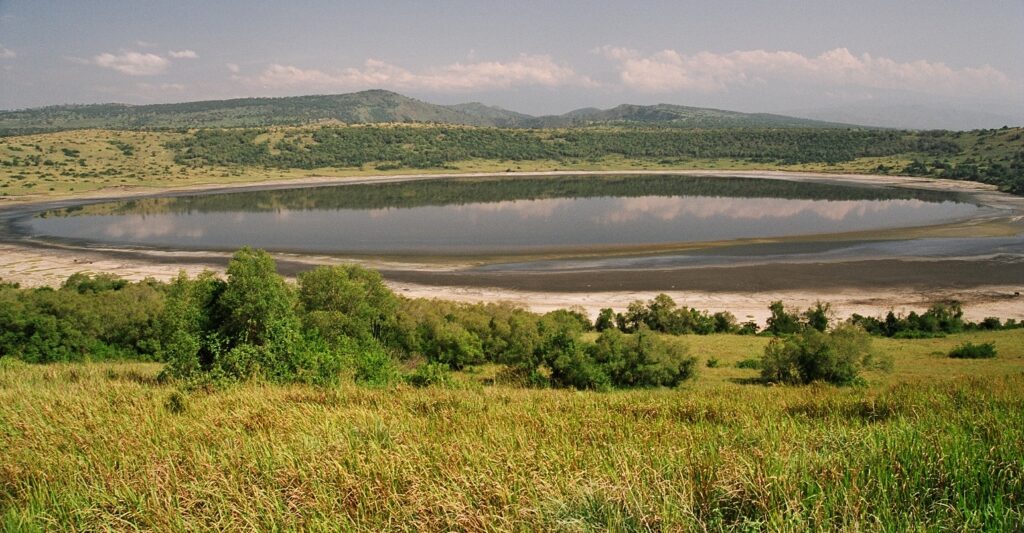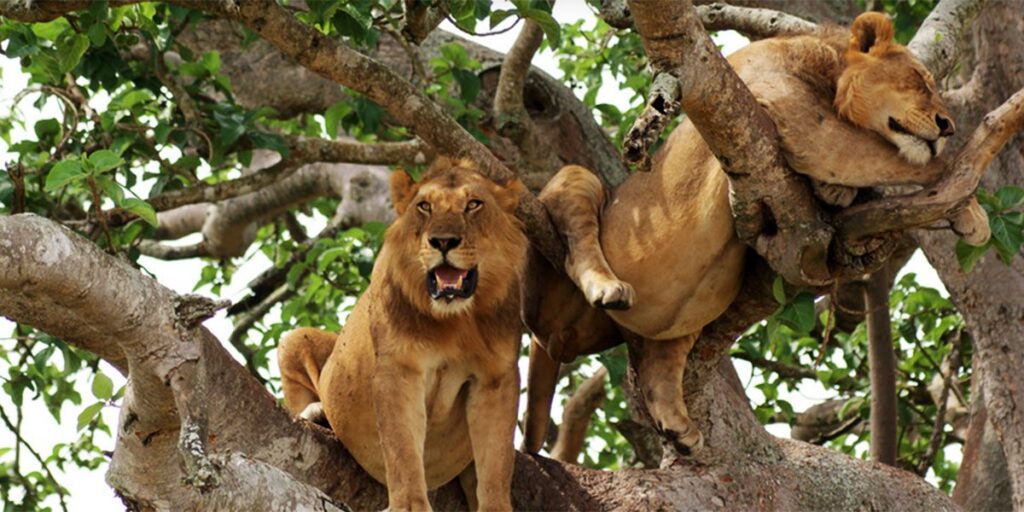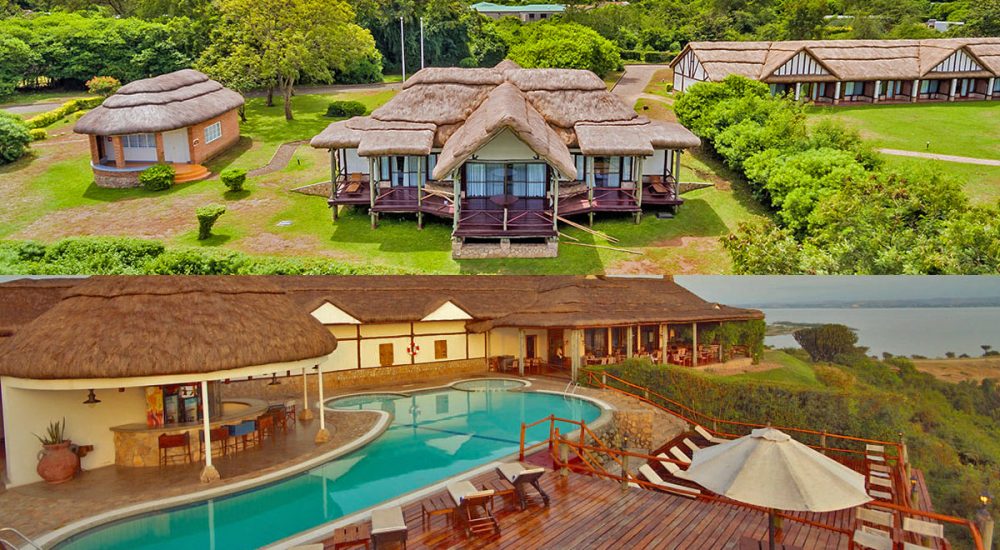Queen Elizabeth National Park
- Home
- National Parks in Uganda
- Queen Elizabeth National Park
Queen Elizabeth National Park

Queen Elizabeth National Park, located in the South Western Region of Uganda, is one of the most popular and ecologically diverse national parks in the country. Established in 1952, it was named after Queen Elizabeth II in commemoration of her visit to Uganda. The park covers approximately 1,978 square kilometers (764 square miles) and is known for its stunning landscapes, rich biodiversity and diverse wildlife.
Geological History of Queen Elizabeth National Park
Queen Elizabeth National Park, located in southwestern Uganda, is one of the most diverse and ecologically rich national parks in Africa. Its geological history is closely related to the formation of the East African Rift System and the dynamic processes that have shaped the region over millions of years. Here is a summary of the geological history of Queen Elizabeth National Park:
Formation of the East African Rift System.
The East African Rift System, which extends from the Afar Triple Junction in Ethiopia to Mozambique, began to train about 30 million years ago due to tectonic forces that caused the Earth’s crust to crack and thin.
The rifting process created a series of parallel faults which led to the formation of the Albertine Rift, a western branch of the Rift of East Africa. Queen Elizabeth National Park is located in this gap.
Volcanic activity.
With the formation of the rift valley, volcanic activity became important. The park is home to the Katwe-Kikorongo Volcanic Field, where many volcanic cones and craters have formed over the past hundred thousand years. These crater lakes, including Lake Katwe, are rich in minerals, especially salt, which has been mined by local communities for centuries.
Formation of the Great Lakes.
The rifting also influenced the formation of the Great Lakes of Africa, including Lakes Edward and George, which are partly in the park. These lakes are interconnected by the Kazinga Channel, a natural waterway that was formed by tectonic processes and erosion. Lake Edward is one of the oldest lakes in the world, dating back millions of years when the Rift Valley began to fill with water.
Sedimentation and erosion.
Over millions of years, the rivers that flowed through the Rift Valley deposited sediments, creating the fertile plains and savannas that dominate much of the park today. The landscape of the park is a mixture of plateaus, volcanic formations and wetlands, formed by deposition and erosion.
The unique geological features and processes that have shaped Queen Elizabeth National Park make it not only a haven for wildlife but also a fascinating area for geological study
Tourist Attractions in Queen Elizabeth National Park

Queen Elizabeth National Park, located in western Uganda, is one of the most popular and diverse national parks in the country. Here are some of the major tourist attractions in the park:
Kazinga Channel
The Kazinga Channel, a natural waterway that connects Lake George and Lake Edward, is known for its rich wildlife. A boat safari along the channel offers views of hippos, crocodiles, elephants and various bird species. This is one of the best places to see large concentrations of hippos and birds, making it a must-see for nature lovers and birdwatchers.
Ishasha Sector
Famous for its tree-climbing lions, the Ishasha sector in the south of the park offers a unique wildlife experience. French lions can often be seen lounging on the branches of fig trees. This rare behavior makes Ishasha one of the few places in the world where you can see lions in the trees, offering a unique photo opportunity.
Mweya Peninsula
Located in the northern part of the park, the Mweya Peninsula is a center for tourists. It offers views of the Kazinga Channel and the Savannah. The peninsula is an excellent base for exploring the park and enjoying the panoramic views, as well as accessing various activities such as boat trips and game drives.
Kyambura Gorge
Known as ‘Monkey Valley’, Kyambura Gorge is a lush and green valley that is home to a population of common chimpanzees. Guided chimpanzee tracking visitors in France are available
The gorge offers a unique opportunity to follow chimpanzees in their natural habitat and discover a magnificent landscape that contrasts with the surrounding Savannah.
Cartered eruption lakes of Katwe
The park is dotted with a series of crater lakes, formed by ancient volcanic eruptions. Lake Katwe, in particular, is known for its traditional salt mining activities, which you can observe. The crater lakes offer stunning scenery and insight into the traditional lifestyle of the local people, who have a diverse and natural cultural experience.
Maramagambo Forest
This dense tropical forest is home to a variety of primates, including chimpanzees, as well as many species of birds and bats. The “Bat Cave” and the Blue Lake are notable attractions in the forest.
It is ideal for nature walks and bird watching, which offers a different type of ecosystem compared to the savannas of the park.
Kasenyi Plains
The Kasenyi Plains are known for their large herds of Uganda Kob which attract predators such as lions and leopards. This is a prime area for safaris.
The ranges offer some of the best game viewing opportunities, especially if you want to see predators in action.
Chimpanzee tracking
Guided tours allow you to observe chimpanzees in their natural habitat, offering an exciting wildlife experience.
Bird watching
The park is a paradise for bird watchers, with more than 600 species of birds, including the African fish eagle, the shoe stork and the flamingos’ cultural tours.
Accommodation in Queen Elizabeth National Park

Queen Elizabeth National Park in Uganda offers a variety of accommodation options, from luxury lodges to campsites as shown below;
Mweya Safari Lodge. Located on a peninsula in the heart of the park, this lodge offers a stunning view of the Kazinga Channel and Lake Edward. It offers luxurious rooms, a swimming pool, a restaurant and organized safaris.
Katara Lodge. Located on the escarpment of the Great Rift Valley, Katara Lodge offers spacious villas with panoramic views of the park. The lodge is known for its eco-friendly design and high-end amenities.
Kyambura Gorge Lodge. This lodge offers a modern and luxurious experience overlooking the Kyambura Gorge. It offers elegant bandas (castles), a swimming pool and personalized service.
Bush Lodge. This eco-friendly lodge offers a close-to-nature experience with tents and private bathrooms. It is located along the Kazinga Channel, which offers excellent wildlife viewing opportunities.
Marafiki Safari Lodge. This lodge offers comfortable tented rooms and log cabins with beautiful views of Lake George. The lodge emphasizes sustainable tourism practices.
Pumba Safari Villas. Located near the park entrance, these villas offer basic but comfortable accommodation at an affordable price. These cottages are ideal for budget-conscious travelers.
Simba Safari Camp. A budget option with different types of accommodation, including dormitories, self-catering cottages and tents. The camp is located on top of a hill with a panoramic view of the park
Ishasha Desert Camp. Although a little more expensive, this camp offers a more rustic experience with tents in the southern sector of the park, known for its climbing arboreti lions
Kazinga Channel Camp, a basic campsite managed by the local community, which offers an authentic experience close to nature. Visitors can pitch their tents and enjoy the wildlife and scenery of the park.
Queen Elizabeth Bush Lodge. Another budget option, this lodge offers camping facilities and is located near the Kazinga Channel
Private Camping. For those looking for a more personalized experience, private campsites are available in the park. These places are usually booked through tour operators and offer a secluded and exclusive by
Luxury houses on the Kazinga Channel. They offer a unique experience, allowing guests to stay on the water with the opportunity to see wildlife directly from the boat. It is a more exclusive and cheaper way to explore the park.
Queen Elizabeth National Park offers a variety of options to suit different budgets and preferences, from luxury lodges to community campsites. When planning a stay, consider factors such as proximity to wildlife, views and the types of activities available nearby, such as safaris, boat cruises or chimpanzee tracking.
Best Time to Visit Queen Elizabeth National Park
The best time to visit Queen Elizabeth National Park is during the dry seasons, which typically occur from June to September and December to February. These times, the weather is more predictable and wildlife is easier to see because animals congregate around water sources. The reduced vegetation also facilitates the observation of animals
Other considerations
From March to May: it is the long rainy season Although the park remains open and the landscape is lush, heavy rains can make some roads impassable and wildlife more difficult to see However, this period is ideal for bird watchers as migratory species are present
In general, the dry seasons offer the best conditions for a safari experience in the Queen Elizabeth National Park
How to Access Queen Elizabeth National Park
To access Queen Elizabeth National Park in Uganda, follow these steps.
By Road
From Kampala (Uganda’s capital)
The park is about 400 km (approximately 6–7 hours) from Kampala via Mbarara. The most common route is Kampala-Mbarara-Bushenyi-Katunguru.
From Entebbe.
If you arrive via Entebbe International Airport, you can drive or take a domestic flight to the park.
By Air
Domestic flights to Kasese or Mweya Airstrip are available from Entebbe or Kampala (Kajansi airfield). Several operators provide scheduled and chartered flights.
Park Entry tips
Fees are payable at the park gates. As of 2024, the fees for foreign non-residents are about $40 USD per adult per day, but always check for the latest rates.
If you’re driving, vehicle entry fees also apply. Make sure your vehicle is suitable for rough terrain if you plan to explore the park extensively.
Binoculars, a camera, sunscreen, insect repellent, a hat, and appropriate clothing for both warm and cool weather.
Carry your ID, passport, and any relevant travel documents.
Popular Safari Destinations
Explorer More Safaris
- 14-Days Uganda Safari Gorilla Chimpanzees and Wildlife
- 12 Days Gorillas and Chimpanzees Wildlife Safari
- 10 days best of uganda primates & wildlife safari
- 6 Days Gorillas and Chimpanzee Trekking Safari
- 3 Day Bwindi Gorilla Trekking Safari
- 4 Day Uganda Gorilla Trekking and Wildlife Safari
- 4 Days Gorilla Trekking and Adventure Safari
- 5 Days Uganda Gorillas and Chimpanzee Tracking Safari
- 4-Day Rwanda Gorilla Trekking and Golden Monkey Tracking Safari
- 5 Day Gorilla Habituation and Chimp Trekking
- 4-Day Uganda & Rwanda Gorilla Trekking Tour
- 3 Days Bwindi Gorilla Trekking Ugnada from Rwanda
- 10 Days Uganda Primates and Game Safari
